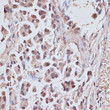| Tissue Specificity | Abundantly expressed in pancreas, less in liver, very low levels in heart and lung. Expressed in the Hep-G2 cell line. Isoform 1 and isoform 2 seem to be present in fetal and adult liver and Hep-G2 cells. |
| Post Translational Modifications | Sumoylated by SUMO1 at Lys-270 during the hepatic acute phase response, leading to promote interaction with GPS2 and prevent N-Cor corepressor complex dissociation. |
| Function | Nuclear receptor that acts as a key metabolic sensor by regulating the expression of genes involved in bile acid synthesis, cholesterol homeostasis and triglyceride synthesis. Together with the oxysterol receptors NR1H3/LXR-alpha and NR1H2/LXR-beta, acts as an essential transcriptional regulator of lipid metabolism. Plays an anti-inflammatory role during the hepatic acute phase response by acting as a corepressor: inhibits the hepatic acute phase response by preventing dissociation of the N-Cor corepressor complex. May be responsible for the liver-specific activity of enhancer II, probably in combination with other hepatocyte transcription factors. Key regulator of cholesterol 7-alpha-hydroxylase gene (CYP7A) expression in liver. May also contribute to the regulation of pancreas-specific genes and play important roles in embryonic development. Activates the transcription of CYP2C38. (Microbial infection) Plays a crucial role for hepatitis B virus gene transcription and DNA replication. Mechanistically, synergistically cooperates with HNF1A to up-regulate the activity of one of the critical cis-elements in the hepatitis B virus genome enhancer II (ENII). |
| Protein Name | Nuclear Receptor Subfamily 5 Group A Member 2Alpha-1-Fetoprotein Transcription FactorB1-Binding FactorHb1fCyp7a Promoter-Binding FactorHepatocytic Transcription FactorLiver Receptor Homolog 1Lrh-1 |
| Database Links | Reactome: R-HSA-210747 O00482-1Reactome: R-HSA-383280Reactome: R-HSA-4090294 O00482-2Reactome: R-HSA-9018519 |
| Cellular Localisation | Nucleus |
| Alternative Antibody Names | Anti-Nuclear Receptor Subfamily 5 Group A Member 2 antibodyAnti-Alpha-1-Fetoprotein Transcription Factor antibodyAnti-B1-Binding Factor antibodyAnti-Hb1f antibodyAnti-Cyp7a Promoter-Binding Factor antibodyAnti-Hepatocytic Transcription Factor antibodyAnti-Liver Receptor Homolog 1 antibodyAnti-Lrh-1 antibodyAnti-NR5A2 antibodyAnti-B1F antibodyAnti-CPF antibodyAnti-FTF antibody |
Information sourced from Uniprot.org








